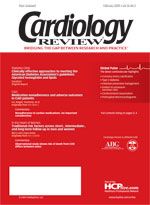Publication
Article
Cardiology Review® Online
Improved retinopathy in a patient with type 1 diabetes: A review of the role for HMG-CoA reductase inhibitors in the treatment of diabetic retinopathy
Author(s):
A 36-year-old Hispanic man was diagnosed with type 1 diabetes in 1987 and dyslipidemia in 2001.
A 36-year-old Hispanic man was diagnosed with type 1 diabetes in 1987 and dyslipidemia in 2001. Eye photos taken in September 2000 showed evidence of background diabetic retinopathy with hard exudates (Figure 1). His glycosylated hemoglobin (A1C) level at that time was 9.8%. Subsequent eye photos taken in January 2001 showed progression of hard exudates (Figure 2), despite improvement of his A1C level to 8.5%. Pharmacologic therapy was started in March 2001 with ceri­vastatin, which was subsequently switched to simvastatin after the withdrawal of cerivastatin from the US market. With HMG-CoA reductase inhibitor (statin) therapy, his low-density lipoprotein (LDL) cholesterol concentration dropped from 135 mg/dL in October 2001 to 79 mg/dL in Dec­ember 2002. Eye photos taken in Dec­ember 2003 showed regression of hard exudates (Figure 3). At that time, his A1C level was 8.7% and LDL cholesterol level was 80 mg/dL.
Diabetic retinopathy is a major cause of morbidity in patients with diabetes and the most common cause of new-onset blindness in adults aged 20 to 74 years. Previous studies have documented the role of glycemic control in preventing the development and progression of diabetic retinopathy in patients with type 1 and type 2 diabetes. But what effect, if any, does treatment of dyslipidemia have on diabetic retinopathy? An improvement in hard exudates and a decrease in microaneurysms were shown in a small series of patients after 1 year of treatment with pravastatin.1 Another study suggested that simvastatin may significantly slow the progression of diabetic retinopathy in diabetic pa­tients with good glycemic control and hypercholesterolemia.2
Background retinopathy in this patient was improved after initiation of statin treatment for dyslipidemia, with minimal change in glycemic control. The role dyslipidemia plays in the development of diabetic retinopathy thus far has not been extensively studied. Several mechanisms proposed include damage to endothelial cells and pericytes by oxidized LDL cholesterol,3 increase in blood viscosity and alterations in the fibrinolytic system,4 and accumulation of basal linear deposits in Bruch’s membrane.5 It is unclear whether the apparent regression in diabetic retinopathy in this patient represents less microvascular disease or whether changes were merely cosmetic; however, these findings, in combination with previous data, suggest that statins may be effective in preventing or slowing the progression of diabetic retinopathy and perhaps may even cause regression of retinal hard exudates. Given that most of the data in the current literature are based on short-term studies, it is evident that long-term studies investigating the potential of statins to prevent and treat diabetic retinopathy are needed.
Acknowledgement
Supported by NIH General Clin­ical Research Center Program M01 RR00425.






